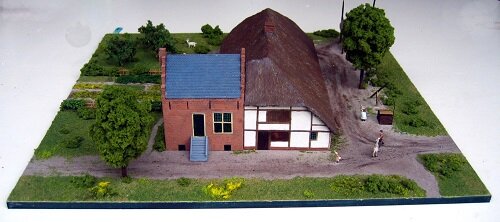
Cultural historical heritage
The Stone Room
The urban development plan, the nature plan, and the architectural plan of Vroondaal are truly unique in the Netherlands. One of the iconic features of the area is the cultural historical heritage site ‘De Stenen Kamer’ /’The Stone Room’. The municipality of Westland was a prosperous region in the Middle Ages, where the nobility cultivated the land behind the dunes and made grand buildings arise, among which a ducal palace in the neighbourhood of ‘s-Gravenzande, castles in proximity to Naaldwijk, the Slot van Polanen in Poeldijk and the noble house in Madestein. The stone foundation of the 13th century manor, situated in the Recreation Area Madestein is valuable in archaeological terms and as a landscape sight.
In 1973 the ruin of the 13th century farm was excavated. The wooden farm had a stone room as an annex, of which the foundation remains. At the time bricks were expensive to use in construction. Only the church and the nobility could afford such luxury. For this reason, a house of stone was exceptional. Such a stone room exuded authority and wealth and gave the residents the status of noblemen. A wealthy family built a country house on the same place in the 17th century. The estate was remodelled in the beginning of the 19th century, of which the addition of a vegetable and fruit garden was a part. A part of the original wall of this garden is still visible today.
The ruin was restored in 2008 by Braaksma & Roos Architects, The Hague. In 2009 the site was made ready to receive visitors by installing benches and platforms on the water. Information on the spot describes the history of the manor and its illustrious residents.
During the first restauration in 1974.
Maquette, 100 x 100 cm, 1973.
Madestein
The recreational area Madestein is one of the largest green area’s in The Hague. This nature park has many facilities, such as a sports complex, a city farm, butterfly garden, allotments and a restaurant. Living in Vroondaal Hofstedepark, you can go for a run in the park Madestein that forms the green hart of Vroondaal.
There are bicycle, walking and riding routes to spend your spare time in nature. In summer, you can swim in the pond in the park and have a drink or a bite to eat at the large terrace of Restaurant Madestein, while the little ones keep themselves entertained in the outdoor playground.
Ockenburgh Estate
The Ockenburgh Estate is to the north of Vroondaal Hofstedepark and has a rich history. In 1650 poet and medic Jacob Westerbaen bought a plot of wild dune and established ‘Buitenplaats Ockenburgh’. He became the founder of cultivation of fruit and vegetables in this region. In those days, his home was a place where notables and writers, such as P.C. Hooft met each other.
Over the past centuries the villa has had many uses. It has been a place to stay for Belgian soldiers, a sanctuary for Jewish children and an airfield . The last period it was used as a hostel and camping site after which is has been empty for many years and decayed.
Petra Brekelmans, one of our residents, initiated the restoration of the old villa and vegetable garden, together with approximately 150 other volunteers in 2015. Since re-opening in 2020 Buitenplaats Ockenburgh is the showpiece of the estate. The estate offers it visitors a walk in the hyacinth forest, blossoming rhododendrons in May, cycling in the park, walking the dog and riding. (www.villaockenburgh.nl)




